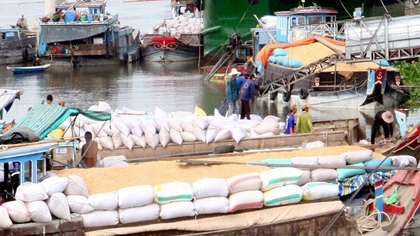Viet Nam needs to create a rice brand: experts
Developing a national brand name is an urgent need for improving the competitiveness of Vietnamese rice, a conference heard in Ho Chi Minh City yesterday.
The fourth rice symposium, organised by Việt Nam Economic Times with support from Bayer Vietnam and titled “How to enhance Việt Nam rice quality and brand positioning to meet market needs” gathered more than 150 experts and officials from Government agencies and representatives of rice trading companies.
 |
| Developing a national brand name is an urgent need for improving the competitiveness of Vietnamese rice, a conference heard in Ho Chi Minh City yesterday. |
Experts told the conference that Vietnamese rice had been exported to over 80 markets including Southeast Asia, the US, Japan, Africa, and the Middle East.
But in recent years exports were not stable and were diminishing due to the lack of clear plans to develop global trademarks for its rice.
Đao The Anh, director of the Centre for Agrarian Systems Research and Development, told the conference that without national brands, Vietnamese rice was often packaged with the name of exporting companies or importing countries.
Even in the domestic market, Vietnamese rice varieties are less competitive than those imported from neigbouring countries, according to Anh.
Some companies have started to build their own brands, but these are yet to become well-known.
It is now imperative to have a national brand name.
Huỳnh Văn Nghiệp, deputy director of the Mekong Delta Rice Research Institution, said the advantage of low labour costs no longer existed.
Production costs kept increasing while rice prices were down due to problems related to quality and trademark.
Besides ensuring quality, expanding the distribution system and improving packaging, Việt Nam should also develop a national brand name for rice, he stressed.
The gathered experts agreed that the brand name for Vietnamese rice must be based on quality.
Anh said Vietnamese rice quality was not uniform because there were many varieties of paddy.
"In the Mekong region alone there are 100 varieties," he pointed out.
He admitted it was very difficult to manage a national trademark with many kinds of paddy, citing the examples of Thailand, whose rice trademark is just for two varieties, and India, for whom it is only for basmati.
Speaking about how to create Vietnamese rice brand names, Kohei Sakata, general director of Bayer Việt Nam, said: “The missing part now, from my perspective, is to really make sure that the quality is as high as required in other markets. We also need to ensure equal quality across different farms and sectors. So in order to achieve high quality at an equal level in many places, the value chain needs to be close to each other.”
Nghiệp said it was a big challenge to develop a national brand for Vietnamese rice.
It needs co-operation among various sectors and companies and a clear plan, according to Nghiệp.
He suggested having national standards for each rice category, saying from that there would be studies to develop them.
Various rice strains should be planted in different areas with different technologies to produce rice of quality that meets international standards, he said.
Food hygiene standards should also be created, he added.
Along with these, the experts said, there should be co-operation among companies to avoid small scale of production.
This year Viêt Nam has been facing many challenges and heightened concerns over the Mekong Delta’s future due to an extremely severe drought which resulted in higher salinity levels in the delta as seawater intruded unusually deep into rivers.
(Source: VNS)
.
 về đầu trang
về đầu trang






